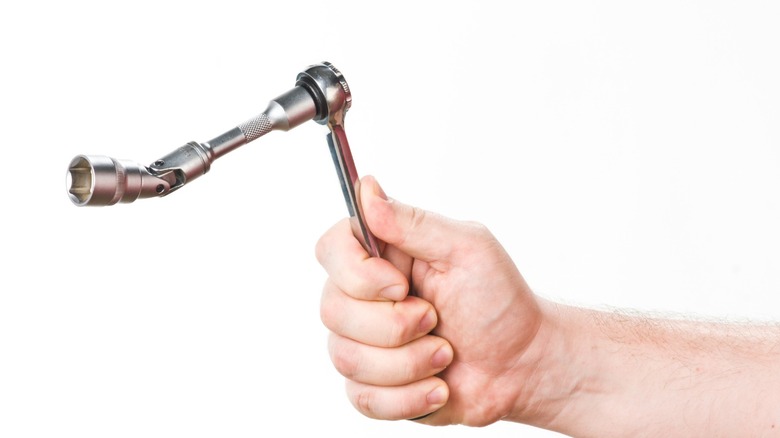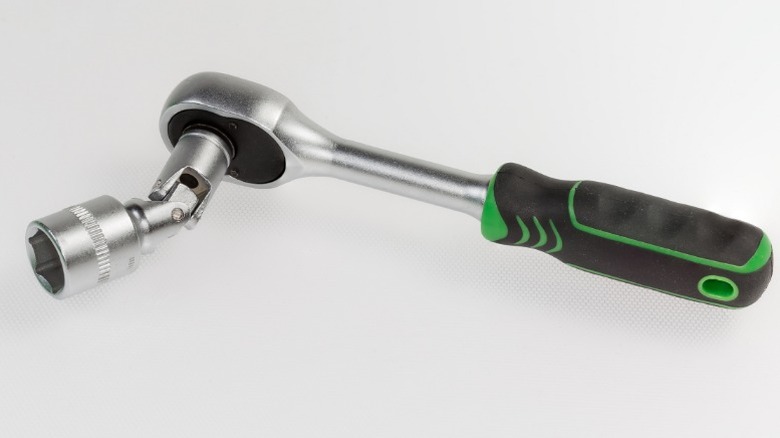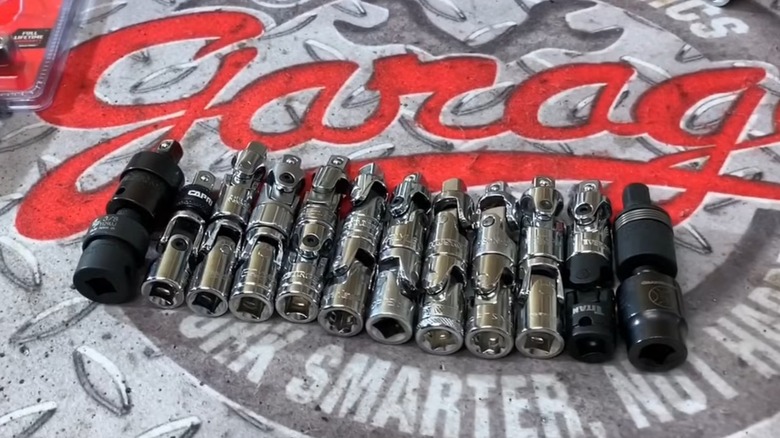What Is A Universal Joint Socket And How Does It Work?
If you work on cars — either as a professional mechanic or as a DIYer — or in another trade requiring the frequent use of sockets and hand tools, you probably understand how tricky some jobs can be, due to cramped spaces. Some repairs are in such tight spots that it's necessary to remove nearby parts to access the damaged area. However, that can drastically increase the amount of work required to complete the job, potentially resulting in hours and pay lost.
Fortunately, you can often use universal joint sockets to work around obstacles in cramped spaces. Universal joint sockets are available in a few different styles, but they all perform a similar task: providing enhanced flexibility when using a socket. These devices pivot, allowing you to use a ratchet and socket at an angle. Universal joint sockets are composed of multiple parts and usually have a base drive end that attaches to your ratchet or drive tool and a socket or extension end. The two ends of the joint connect at a pivot point, which allows for a certain degree of motion (usually between 45 and 90 degrees) in one or more directions.
Universal joint sockets are extremely useful items to keep in your mechanic's toolkit. However, not all universal joint sockets are the same, and there are some things you should know before you try using one.
How to use a universal joint socket
Using a universal joint socket isn't too difficult, but there are some things you should be aware of before you get started. If you're using a ratchet, you'll most likely also be using an extension if you need a universal joint socket. In this case, you attach the universal joint socket to the extension just like you would a normal socket.
It may be tricky to get the socket onto the fastener, due to the awkward angle that necessitates the use of a universal joint in the first place. Using two hands or positioning the joint at the proper angle before you try to grasp the fastener can help with this step. Once you position the socket on the fastener, you can use your ratchet to remove the nut or bolt as normal. It may take a bit more effort to break fasteners free while using a universal joint socket, though, so you should move at a slow and steady pace to avoid damaging your tools.
If you're using a universal joint socket with a pneumatic or cordless impact tool, you need to take special precautions. You should move much slower when using a universal joint than you would with a normal socket, and you should avoid using universal joints when installing fasteners that must be torqued to precise tightness ratings. Impact-rated universal joint sockets are the best option for use with power tools. However, these devices usually provide a reduced range of motion when compared to chrome versions. You can use chrome universal joints with an impact, but you should do so very slowly to avoid blowing out the socket's drive end and to prevent the socket from binding as it spins.
What are the different types of universal joint sockets?
As mentioned, there are several different types of universal joint sockets, and each type can be beneficial for different scenarios. One of the most common variations of universal joint sockets is constructed from chrome vanadium and provides up to 90 degrees of pivot action. These devices typically look somewhat tubular and have a joint in the middle where the socket is able to flex. These types of universal joints can come as traditional sockets, meaning they have a 6 or 12-point socket head on one end and a female connection on the other end for ratchets. Alternatively, they can be extensions, which function similarly and have the same basic shape, but have a female drive end and a male drive end, allowing you to attach a regular socket.
Another type of universal joint socket you're likely to encounter is impact-rated versions. These devices typically offer less flexibility (usually around 45 degrees) and usually have a slightly different shape. Impact-rated universal sockets typically have a round drive end, and the pivot point is shaped like a sphere with a pin through it. These universal joints are significantly more durable than the chrome vanadium varieties. They tend to bind up less when in use, and you can safely use them with impacts without causing damage to the socket itself. Like the chrome vanadium universal joint sockets, impact-rated universal joints can come as sockets or extensions.
One final device worth mentioning is wobble extensions. While they're not universal joints, wobble extensions are frequently used in tandem with these sockets. They allow you to attach a socket loosely to the extension so that it pivots, providing an enhanced range of motion and, when combined with universal joints, making tough, cramped jobs substantially easier to tackle.


